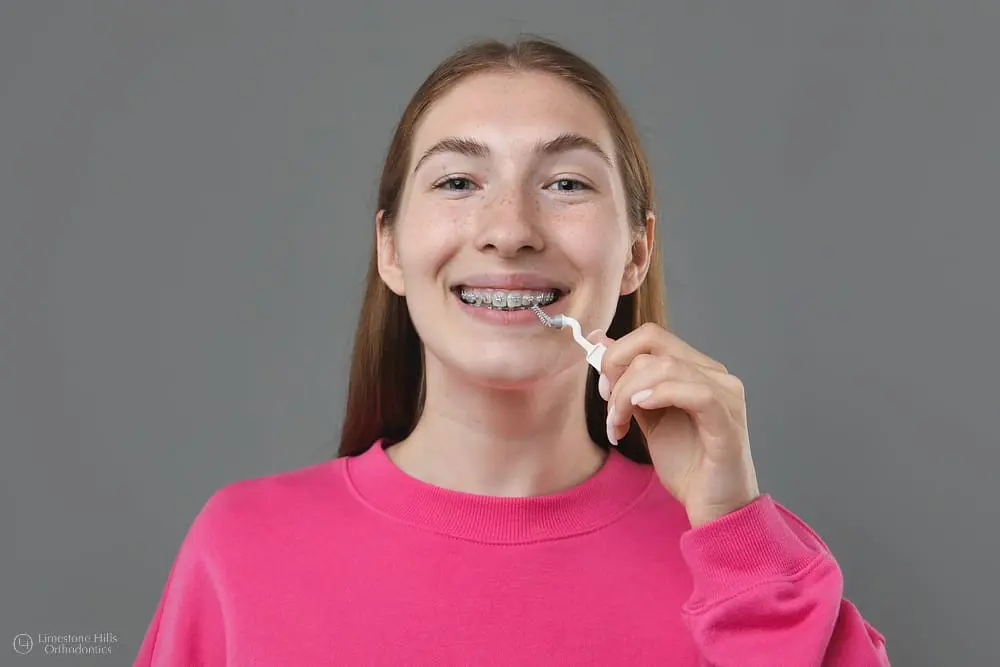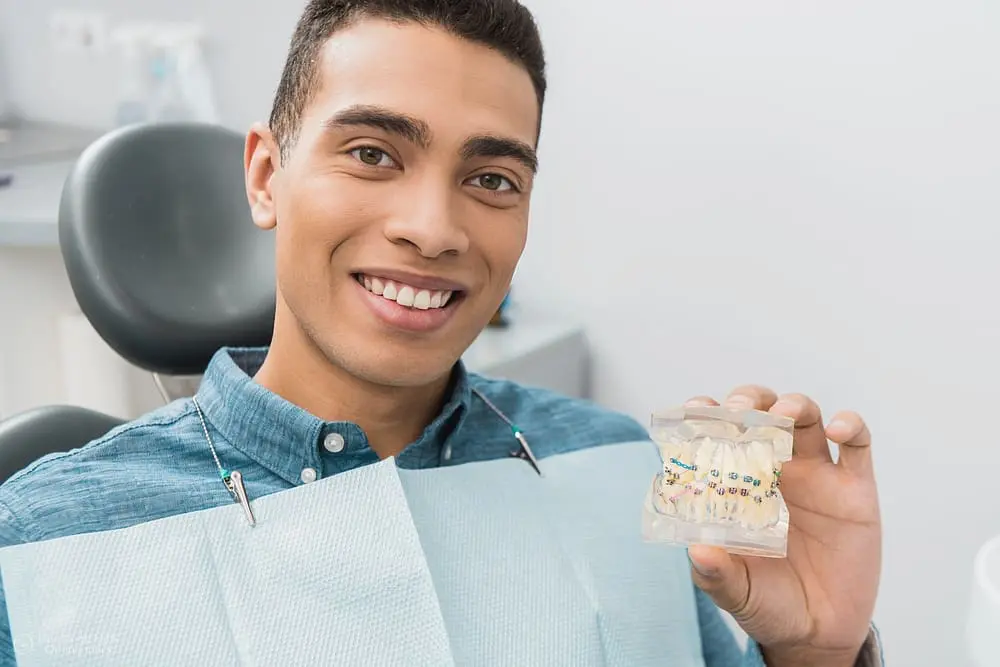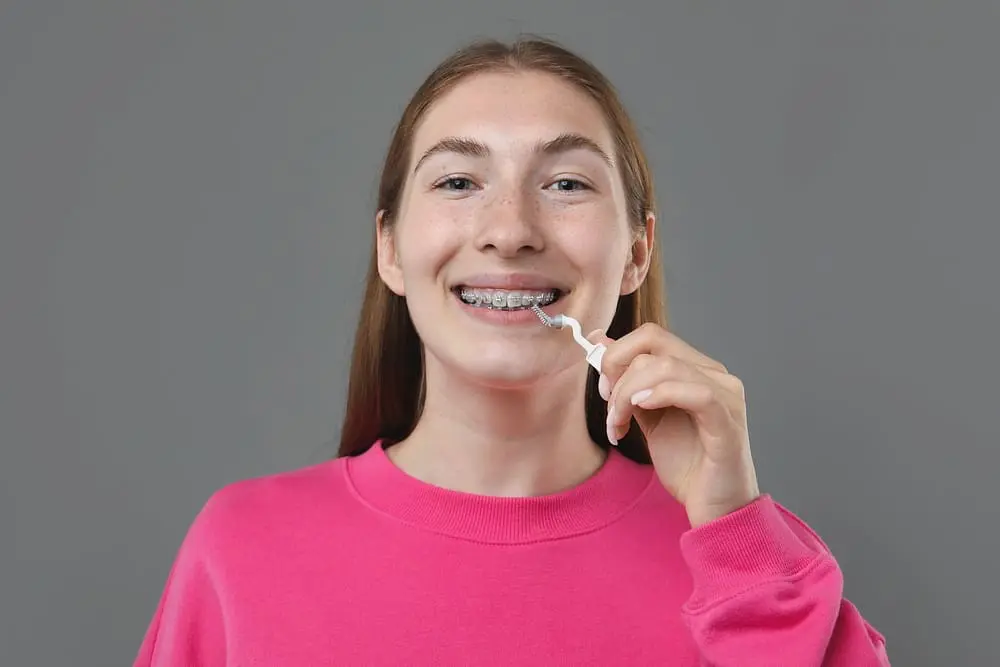Braces themselves don’t stain your teeth, but they can make it a bit trickier to keep your pearly whites sparkling clean. The brackets and wires can create little nooks and crannies where food particles and plaque love to hide. If these aren’t cleaned away properly, they can lead to staining or even cavities over time.
So, can braces stain my teeth? Not directly—but poor oral hygiene during treatment can. But don’t worry! With diligent brushing, flossing, and regular dental check-ups, you can keep your smile bright and healthy while rocking those braces. Remember, your orthodontist is there to help, so don’t hesitate to ask for tips on maintaining that dazzling smile!

Causes of Tooth Staining with Braces
Tooth staining can happen when braces are not paired with good oral care. Here are some key factors that contribute to discoloration:
1. Bracket and Wire Material
The brackets and wires used in braces can sometimes trap food particles and plaque, which increases the chances of staining. If you do not clean around these materials thoroughly, stains may develop where the brackets attached to your teeth.
2. Plaque Buildup
Plaque is a sticky layer of bacteria that forms on teeth. It tends to gather around braces, especially where the brackets and wires meet. If plaque builds up and isn’t removed, it hardens into tartar, which can discolor teeth.
3. Staining Foods and Drinks
Certain foods and beverages are more likely to stain teeth, particularly when wearing braces. These include:
- Dark beverages: Coffee, tea, and soda can cause stains.
- Colorful foods: Berries, tomato sauces, and curry can leave behind discoloration.
- Sugary snacks: Sticky candies and sugary treats encourage plaque buildup, leading to stains.
Limiting these foods and drinks during your treatment can significantly reduce the chances of staining.
4. Poor Oral Hygiene Practices
Inconsistent brushing and flossing increase the risk of stains. When you don’t clean your teeth properly, plaque stays on your teeth longer, leading to discoloration around the brackets and gumline.
Preventing Stains While Wearing Braces
The good news is that stains can be prevented with a well-planned oral care routine and lifestyle adjustments.
1. Regular Brushing and Flossing
Brushing and flossing are your first line of defense against plaque buildup. Brush your teeth at least twice a day, and use floss threaders or orthodontic floss to get between braces and wires.
2. Use of Soft-Bristle Brushes
Soft-bristle toothbrushes are gentle on teeth and gums, making them ideal for cleaning braces. They’re effective at getting around brackets and wires without causing damage. Electric toothbrushes with special orthodontic heads can also be very helpful.
3. Dietary Adjustments
What you eat matters when it comes to preventing stains. To protect your teeth, limit or avoid:
- Dark drinks like coffee, tea, and red wine.
- Acidic drinks like soda, which can weaken enamel.
- Foods with natural or artificial coloring, such as berries, candy, or brightly colored sauces.
Eating more braces-friendly foods, such as plain yogurt, bananas, and steamed veggies, can help keep your teeth clean and reduce staining risks.
4. Professional Cleanings
Visiting your dentist regularly for professional cleanings is crucial when you have braces. Dental professionals can remove plaque and tartar buildup that you might miss during daily brushing and flossing. Regular cleanings can prevent stains from becoming permanent.
Managing Stains and Maintaining Tooth Color
If stains occur despite your best efforts, there are ways to address them after your braces are removed.
1. Composite Restoration
Composite resin can be used to repair discoloration and restore the natural look of your teeth after braces. This method is especially helpful for addressing areas that are darker or unevenly colored.
2. Color Restoration Techniques
After your braces are removed, teeth whitening treatments can brighten your smile. Options include professional whitening at the dentist’s office or at-home whitening kits with custom trays.
3. Addressing White Spots
In some cases, white spots form on teeth during orthodontic treatment. These are areas where plaque was not cleaned properly, causing enamel demineralization. Treatments to address white spots may include:
- Topical fluoride treatments: Fluoride can help rebuild weakened enamel.
- Microabrasion: Light polishing removes surface-level spots.
- Resin infiltration: A technique that fills affected areas with resin to match your tooth color.
Your dentist will recommend the best solution based on the severity of the problem.
Importance of Oral Hygiene During Orthodontic Treatment
Good oral hygiene is essential for preventing stains and keeping your teeth and gums healthy throughout your orthodontic journey.
1. Preventing Tooth Decay and Gum Disease
Braces create more areas for bacteria to hide, so proper cleaning is vital to prevent tooth decay and gum disease. Keep plaque at bay to ensure your teeth and gums remain healthy during and after treatment.
2. Removing Food Particles
Toothbrushes and floss tools designed for braces help remove food particles that can accumulate around brackets and wires. Rinsing with water or a mouthwash after meals can further help keep your mouth clean.
3. Maintaining Consistency
Make oral care part of your daily routine. Aim to brush for at least two minutes and focus on cleaning around each bracket and along the gumline. Consistency will pay off, helping you avoid staining and plaque issues.

Why Choose Our Orthodontic Practice in Austin, TX?
At our Austin orthodontic office, we’re dedicated to providing high-quality, personalized care to every patient. Here’s why families trust us for their orthodontic needs:
Experienced Orthodontic Experts
Our skilled orthodontists have years of experience treating children and teens with jaw alignment issues. We specialize in effective treatments like reverse pull headgear, delivering exceptional results tailored to each patient.
Customized Treatment Plans
No two smiles are the same, which is why we design personalized treatment plans to meet your child’s unique needs and goals, ensuring the best possible outcome.
Comprehensive Support Throughout Treatment
From your very first consultation to the final reveal of your new smile, our caring team is here to support you. We’re always available to answer questions, make adjustments, and offer guidance every step of the way.
A Wide Range of Treatment Options
We offer more than just reverse pull headgear. Our practice provides a variety of orthodontic solutions, including Invisalign and traditional braces, so we can find the perfect fit for every patient.
Schedule Your Free Consultation Today!
Come see us in Austin, TX, for a free consultation! During your visit, we’ll assess your teeth, go over your treatment options, and discuss how we can help you achieve a straight, confident smile. Scheduling is simple—give us a call or visit our website to book a time that works for you! Our friendly team is ready to answer your questions and guide you every step of the way.
About the Authors
Dr. Rodrigo Viecilli – Orthodontist in Austin, TX
Frequently Asked Questions
Do teeth stains from braces go away?
Teeth stains from braces can definitely go away! Once your braces are removed, your teeth might have some temporary discoloration, but don’t worry. Regular brushing, flossing, and professional cleanings can help brighten your smile. Over time, any stains usually fade, and if you want an extra boost, whitening treatments can be a great option.
How to remove yellow stains from braces?
Start by brushing your teeth thoroughly after every meal with a fluoride toothpaste and a soft-bristled toothbrush. You might also want to try using an interdental brush or a water flosser to get into those hard-to-reach spots around the brackets. Rinsing with a mouthwash can also help keep your braces sparkling clean. For a little extra help, consider using a whitening toothpaste once or twice a week, but make sure it’s safe for braces.


